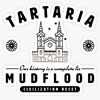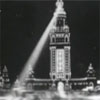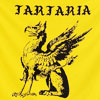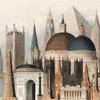Tartaria: The Hidden Empire
 by David Vanderper
by David Vanderper
What Is Tartaria?
Tartaria (originally pronounced “Tataria” without the first “r”) is the name of the pre-Mongolian empire that originated in northern Asia before spanning the entire northern hemisphere. Great Tartaria was the largest empire during its time and would have still been the largest empire today. The Tartarian Empire flourished due in part of the civilization being a leader in advanced technology, free energy, and grand architecture.
Tartaria is also where the Greek word “Tartarus” originated from.
The denotation of lost souls spending eternity in Tartarus the underworld is due to the Tartarian Empire having been buried and wiped out during the mud flood. The world of the Tartarians is literally the world under our world. The underworld. Tartarus wasn’t the underworld and will never be the underworld. Tartaria is the underworld. The religionists used the Mud Flood deluge and how it wiped out the Tartarian Empire to confuse the populous into thinking they would join those in the “underworld” if they challenged the religious authority.
Who Were The Tartarians?
The Tartarians (or Tartars) were the indigenous people (quite possibly founded by Noah’s sons) making up the world renowned Tartarian Empire. The Tartarians were a tall people, averaging some eight to twelve feet in height. They would have been considered giants to our current average height of only around six feet; however, back then the height of ten feet was the average. Like the civilizations before them whose heights averaged twelve feet, fifty feet, two+ miles, etc…each preceding civilization had an average taller height than the civilizations coming after them and each succeeding civilization had an average shorter height than the civilizations predating them. Statures are diminishing after each deluge and with each new astrological age we enter.
Civilizations in the current astrological age (the Age of Pisces) are shorter in height than civilizations that existed in the previous astrological age (the Age of Aries) and will be taller in height than civilizations that will exist in the next astrological age (the Age of Aquarius).
The Tartarians are thought to have been “Breatherians,” a being who does not rely on the digestion and burning of calories from food/water, but instead rather receives energy straight from the aether. The aether is thought to be the very fabric of the space-time continuum that some would associate with electrons, the wind, the holy spirit, the atmosphere, and the gasses in the atmosphere such as oxygen, nitrogen, and hydrogen. Since the the Tartarians quite possibly had a completely altered digestive system than the one we now have, they had no need for toilets in their bathrooms. Which could hint at one of the reasons why bathrooms in the recent past have been used quite extensively as social gathering powder rooms to not only freshen oneself up but to hear and spread local gossip.
The Tartarians were masters of masonry, brickwork, steam-punk style technology, universally free energy, and grand architecture. Their Roman/Gothic esque style architecture can still be found in the current guise as water ducts, city halls, banks, water stations, cathedrals, churches, hospitals and similar public and city works type buildings.
What Is The Mud Flood?
The epic “Mud Flood” is a term that is coined to the event which occurred only a few hundred years ago during the end of the reign of the Tartarian Empire.
Buildings hundreds of years old and located all across the world are known to be encased in a mud flow up to several stories high and in some cases even completely engulfing buildings entirely in nothing but mud.
You can find buildings that have an age of only a few hundred years old and find them to be buried in mud. The windows and doors of the upper floors of buildings are quite often found to be at ground level and occasionally even found to be completely buried underneath the surface of the mud that covered the entire area.
Tartarian Free Energy
Churches, cathedrals, mosques, and other buildings of worship were originally aetheric power stations, water stations, and sound resonating acoustical healing centers.
The buildings that religionists use as places of worship in our present day originally functioned as hospitals or healing centers during the reign of the Tartarian Empire.
Tartarian buildings are more similar in function to pyramids and temples found across the world than what we are lead to believe by mainstream peer reviewed science.
Through ingenious engineering, intricate architecture, and advanced technology, the Tartarians transformed the earth into a circuit board powered by the aether. Just like the ancients did with the pyramids and temples.
The crosses on top of Tartarian buildings were used as aetheric electrical antennas which were connected to the rebar embedded throughout the building’s structure.
Streetlights that existed during the reign of the Tartarian Empire were tall aetheric electrical antennas. These streetlights harnessed the power of the aether which caused the gasses inside of the upper bulb to ionize and fluoresce.
For all we know the upper bulbs that sat on top of the Tartarian streetlights and found inside the homes of the Tartars themselves were not made from glass, but quite possibly from a type of quartz crystal. If the pop cultural phenomenon started by the Radium Girls are any indication, then these bulbs could have contained various substances such as mercury or radium which reacted with the aether or maybe the bulbs contained nothing at all and the quartz crystal itself is what reacted with the aether.
How did the first fireplaces and chimneys function?
The Design
Tartarian fireplaces were as ornamentaly grand as the buildings that they resided in. These fireplaces were used as a type of bragging rights by revealing the intricate architecture of the homeowner’s taste to visiting guests and relatives.
Contrary to how we use fireplaces today, fireplaces themselves were not engineered to burn anything. Chimneys were not used to route smoke from the fireplace to the outside of the home; and rebar in the structure of the home was not primarily used to provide any structural support.
The rebar in the home was connected to the roof top tower dome (which was quite possibly filled with various substances such as mercury, radium, or quartz crystal) and the metal poles sticking out of the top and sides of the building. All of this metal was then connected to the metal back plating found inside the original Tartarian fireplaces and chimneys.
Like the crosses found on top of churches, cathedrals, and mosques…the metal poles sticking out of the top and sides of homes and other Tartarian buildings acted as aetheric electrical antennas which harnessed the power of the aether and focused that free energy into the chimney.
Air ventilation shafts (air ducts) found throughout the home’s rooms were connected to the chimney.
The rebar, roof top tower dome, and metal poles sticking out of the sides of the home acted as a spider web, attracting the aether and concentrating the aetheric energy all throughout the home. Similar to how spiders are able to grow and survive without food and water so long as they are touching their web, the Tartarians were able to grow and survive without food and water so long as they stayed inside of their aetheric energized home.
Tartarian fireplaces and chimneys functioned as aetheric electrical vacuums (ionized central air units)
Tartarian fireplaces and chimneys were pressurized electric vacuums which acted as an air circulation unit inside of the home. The chimney itself was the vacuum chamber where everything took place.
The Winter
During the winter, the homeowner would close the upper portion of the chimney.
The connected rebar from the house focused the frictional heat from the rebar under stress from the structure into the chimney by way of the metal back plate.
The ornamentaly grand metallic sculptings typically found decorating the outer perimeter of Tartarian fireplaces acted as capacitors by storing the built up aetheric energy collected by the roof top tower dome and top and side metal poles sticking out of the house. These metal sculptings were connected to the metal back plate found inside of the fireplace and up and down the chimney.
Along with the metal back plate, these metal sculptings were aetheric electrically charged due in part to being connected to the metal back plate which in turn was connected to the building’s rebar while the rebar was connected to the roof top tower dome and metal poles sticking out of the top and sides of the building which were used as antennas to help attract the universal energy of the aether itself. The fireplace’s metal sculptings helped to radiate structural tension heat from the rebar and metal back plate into the room where the fireplace was located.
Since the heat could not escape up through the chimney, the heat would then be forced to radiate throughout the chimney itself.
The heat would then be forced to radiate into the ventilation air ducts which were connected to the inside of the chimney.
The heat would travel inside of the ventilation air ducts and heat the rooms where the air ducts opened up to.
The rest of the heat trapped inside of the chimney would radiate out of the fireplace itself and with the help of the fireplace’s metal sculptings, heat the room it was in.
The heat output this type of central air circulation system, would be dependent on the amount of rebar in the house, the amount of tensional stress applied to the rebar, whether or not the house had a tower dome and metal poles on the outside that were connected to the rebar inside, the size of the chimney, the size of the metal back plate, the size of the fireplace, and the size of the fireplace’s metal sculptings.
The Summer
During the summer, the homeowner would open the upper portion of the chimney.
The fireplace would act as a pressurized vacuum powered by the aetheric electricity and suck the heat out of the rooms in the house by way of the air ventilation ducts and the fireplace itself.
The frictional heat that the connected rebar was under due to tensional stress from the house would begin to radiate up and out of the chimney.
In short…
Tartarian fireplaces were not designed to burn anything. The metal back plating found inside of the fireplace and chimney was connected to the rebar, upper tower dome, and outside metal poles which concentrated the power of the aether and focused that free energy onto the metal back plate inside of the chimney which ionized the air inside of the chimney. This ionized air coupled with the rising and falling of hot and cold air currents created a pressurized electric vacuum inside of the chimney. During the winter, chimneys acted as pressurized electric vacuums radiating trapped heat inside of the chimney out through the fireplace, metal sculptings, and air ventilation ducts connected to the inside of the chimney. During the summer, the process would reverse and the fireplace and air ventilation ducts would suck in heat into the fireplace and air ducts connected to the inside of the chimney from the inside of the house and by way of the ionized air from the aetheric electrically charged metal back plate inside of the chimney would force the heat up the chimney and out of the house.
Free Energy Devices
There are five conceptualized theories as to what the original purpose was of the Tartarian fireplaces and chimneys.
Pressurized Aetheric Electric Vacuums
All of the metal poles sticking out of the house and the roof top tower dome were connected to the rebar in the house’s structure. The rebar was connected to the metal back plate found inside of the chimney. The heat caused by the tension friction from the rebar under stress focused the heat into the chimney by way of being connected to the chimney’s back plate. The metal poles sticking out of the house along with the roof top tower dome were aetheric electrical antennas which routed the wireless aetheric energy to the rebar. The rebar focused the aetheric energy into the chimney and onto the metal back plate which ionized the atoms of the metal back plate and the frictional heat trapped inside of the chimney. The aetheric ionized electricity being conducted inside of the chimney helped to quickly route the frictional heat of the rebar under tension stress up and out of the chimney during the summer (an open chimney) and through and out of the fireplace and air circulation ducts connected to the inside of the chimney during the winter (a closed chimney).
In-Home Aetheric Streetlight Technology
Similar to how Tartarian streetlights and “religious crosses” acted as aetheric electrical antennas, the metal poles and roof top tower domes on houses harnessed the energy from the aether and focused that energy into the connected rebar. The aetheric powered rebar itself would protrude into rooms throughout the home with gaseous bulbs connected to the ends of the rebar. The aetheric energy would ionize the gasses contained within the bulbs to provide illumination for that particular room.
Gaseous Charging Stations
The Tartarians had hand held vials of gasses contained inside of a portable bulb, similar to that of a flashlight, mobile lamp, and a candle inside of a hand held candle holder. In order to charge the gasses contained inside of the portable bulb, the Tartarian would place the bulb inside of the fireplace. The aetheric ionized energy contained inside of the chimney would ionize the gasses contained inside of the portable bulb. Once fully ionized, the Tartarian would remove the portable bulb from the fireplace and use the ionized gasses contained inside of the portable bulb to provide illumination.
Molecular Transportation
Tartarian fireplaces were also used as a form of electronic wireless molecular transportation using the ionized aetheric chamber (chimney) as a means of demoleculerizing and becoming one with the aether itself. The Tartarians would walk inside of the massive fireplaces and demolecularize. Their soul (consciousness plus memory) would then become one with the aether and the universal energy state. They would then be able to transport or teleport to any place and at anytime they want via the all exsistant aether.
Acoustical Healing Units
Similarly to how Tartarian churches, cathedrals, and mosques originally were used for, Tartarian fireplaces and chimneys could have functioned as acoustical healing units. The roof top tower dome and outside metal poles attracted the power of the aetheric energy. This energy was routed by way of the home’s rebar and focused that aetheric energy into the chimney and onto the metal back plate found inside of the chimney. This energetic metal back plate would ionize the air inside of the chimney and route the aetheric energy out of the fireplace and through the air ducts connected to the inside of the chimney which opened up to rooms found throughout the home. This aetheric energy would provide acoustical healing to anyone near the fireplace, air ducts, or anyone in or around the Tartarian home.
Believe nothing, question everything.
 The Tartarian Empire by The Observation Lounge
The Tartarian Empire by The Observation Lounge
Take a further deep dive into the fascinating theory of the Tartarian Empire with our comprehensive exploration! This video unravels the mysteries of the Tartarian Empire, including the mud flood phenomenon, star forts, world’s fairs, historical US city fires, incubator babies, airships, and the enigmatic orphan trains. Join us on this intriguing journey through history, conspiracy, and theory!
Back up link for above video.
THE GREAT RESET: DECODING THE MYSTERY OF TARTARIA, TESLA, MUD FLOODS, AND FREE WIRELESS ELECTRICITY
Posted in Other Topics, True History of Manwith no comments yet.






Leave a Reply